Precursor to the Mỹ Lai Massacre: 1968 Phong Nhị, Phong Nhất_#8(1)
Chapter 8(1): The Older Brother who went to Vietnam, only to be found in Pyongyang
“Hey, rotate knockout!”
He had no idea what that meant, “rotate knockout.” Someone placed a bucket over his head. It was a whitish metal bucket with a handle. Six to seven men, some dressed in military uniform and others in regular clothes, encircled him and started punching him in his chest and stomach. Combat boots stamps marked his shin, knees and thighs. He was beaten on the shoulders, back and side with a stick. They took turns inflicting pain on him, each man with his hands, feet and tools, as the metal bucket over his head clattered ceaselessly.
There was no way to see the actual assailants. All he could do was sit there taking each blow. Twenty minutes or so later, Section Chief Choi, who had dragged him there, demanded to know who had been there.
“Nobody.”
“You better tell the truth!”
“I really don’t know.”
After much interrogation and abuse, Section Chief Choi pulled out his bayonet. The weapon appeared piercingly sharp.
“If you ever tell anyone about what happened here today, you’re dead.”
It was February 20, 1968. Ahn Yong-soo (16) can never forget this day when his torture began, nor the stranger who came by in a black jeep to his home in Dooho-dong, Buk-gu, Pohang, Gyeongbuk. People referred to the stranger, a man in a leather jacket who appeared to be in his 30s, as Section Chief Choi. Choi insisted that Yong-soo come with him, taking him to the ‘Taebaek Construction’ building located in the corner of Pohang High School (Daeshin-dong, Pohang), where Yong-soo would soon attend. It was actually an interrogation room of the Army Security Command, Pohang office, where Choi abruptly demanded, “According to intelligence, someone was supposed to come here. Who was it?”
It was a chaotic time, with news reports on the failed attempt of the communist guerillas to attack the Blue House, the capturing of the USS Pueblo by the North Korean navy, and the U.S.-ROK-Vietnamese allied troops’ sweep-up operation in reaction to the Viet Cong’s Tet Offensive.
There was an avid anticommunist demonstration for days. The military tension between North and South Korea reached its peak since the Korean War. South Koreans were seething with animosity toward North Korea. Dong-A Ilbo selected an anti-espionage slogan daily and published it on the general news page. “May the entirety of the South Korean populace come together as one to pulverize the brutality of the North Korean puppet regime!” “Our neighborhood made jubilant through defeating the ambition of the North Korean puppet regime.” “Uproot the communist reds, collectively as one!” It was a widespread campaign to knock out the commies. But this was too extreme. To take it as far as to tie up the fate of an oblivious young high school student in the suburbs.
The boy’s household was peaceful until the interrogations and torture began. His father, Ahn Youngsul (46) was a respected educator. Owing to his anti-Japanese education movement, he became a principal of an elementary school from 1948, when he was 26 years old. He was the youngest principal nationwide. In 1968, he became the principal of East Pohang Elementary School. The fact that he too, like Park Chung-hee, was an alumnus of the Daegu University of Education was a splendid background for him. There were even rumors that he will soon move to Seoul in order to serve at the Blue House as the Official Education Executive.
Yong-soo and his four brothers all managed to live up to the expectation and love bestowed on them by their parents. The eldest, Ahn Seong-su (27), was an employee at a public enterprise. Next in line, Ahn Hak-soo (25), was a dispatched military personnel in Vietnam. Ahn In-soo (19) was a senior at the reputable Pohang High School. The fourth brother, Ahn Yong-soo, had also passed the matriculation exam for Pohang High. Their youngest brother, Ahn Chulsoo (13) was about to start at the Pohang Dongji Middle School. Eleven months ago that day, the family was as happy as can be, oblivious to the arrow of destruction that was headed their way.
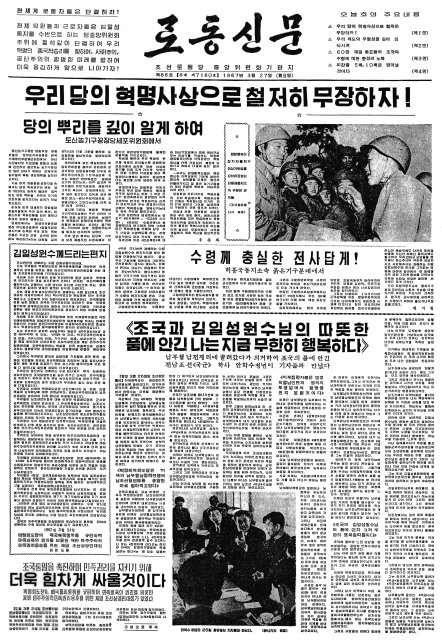
<Rodong Shinmun> reported on March 27, 1967 that South Korean army staff sergeant, Ahn Hak-soo defected to North Korea and held a press meeting. The intelligence agency eliminated the possibility of kidnap and concluded that Ahn is a defector based on North Korean press releases.
It was morning of March 27, 1967. Ahn Yong-soo, who was in his third year at the Pohang Middle School, left his home at the Dongbu Elementary School principal’s official residence. He was walking across the school field in order to get to the big road when the lady from the local stationery store came running toward him from the opposite end with startled expression on her face. “Good heavens, Yong-soo, your brother Hak-soo came out on Pyongyang Radio!”
Hak-soo, Yong-soo’s second oldest brother, was a Korean official drafted to Vietnam in September of 1964. He had since been working as a signal corpsman at the first mobile army surgical hospital of the Dove Unit in Vũng Tàu, a harbor city south of Saigon. The 130 staff members of the first mobile army surgical hospital, along with 10 Taekwondo instructors, were of the first Korean troops dispatched to Vietnam. They treated South Vietnamese soldiers and civilians and Ahn Hak-soo was scheduled to return to Korea on September 16, 1966, but for reasons unknown, their return was delayed. Yong-soo’s father was greatly anticipating his son’s return, trying to figure out his whereabouts. How could Hak-soo have been on Pyongyang Radio? The lady from the stationery store urged Yong-soo to hurry home and turn on the radio.
Daegu Cultural Broadcasting in Pohang would sometimes get interchanged with North Korea’s propaganda to South Korea. While trying to tune in the radio to the Daegue Cultural channel, people would often end up with propaganda. If they hadn’t heard a familiar voice, they might have reattempted to tune in to the Daegue Cultural channel. But they heard the voice of Ahn Hak-soo, who was supposed to be in Vietnam, saying he had defected to North Korea. Ahn Hak-soo’s voice sounded somewhat hoarse and shaky as he spoke. “I lived a pathetic life in South Korea, eating cigarette butts that U.S. soldiers would throw in the streets. My father is a public educational official. There are many ROK soldiers who want to defect to the North from Vietnam. I voluntarily defected to the North into the arms of our dear leader, Kim Il-sung.”
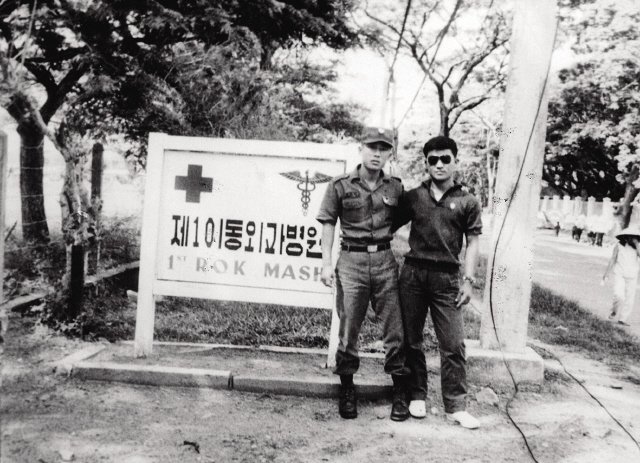
Staff sergeant, Ahn Hak-soo (Left), who, after being kidnapped, appeared on Pyongyang’s broadcast propaganda to South Korea, striking a pose in front of the first mobile army surgical hospital in Vũng Tàu, circa July, 1966.
Ahn Hak-soo was an outgoing, upright, and intelligent man. After graduating from Gyeongju High School, he failed to enter the university of his choice, so he was repeating a year before a recruiting officer that he coincidentally met convinced him to enlist in the army. He joined in September of 1963, graduated at the top of his class in a correspondence school, and was working as a signal corpsman in Daegu, 5th district. His family was extremely proud of him for having been the only one temporarily dispatched to Vietnam as a signal corpsman at the recommendation of the commanding officer. No matter how hard his family tried, it was difficult to conceive that Hak-soo would have intentionally initiated contact with the Viet Cong in order to become a defector.
Their mother Nam Geum-soon (46) fainted at the news. Their father contacted an executive he knew well at the Central Intelligence Agency. That day at midnight, two officers from the agency came to their official residence. They were very courteous. While one officer stood in the doorway, the other explained the details of Ahn Hak-soo’s appearance on North Korean propaganda. They guessed that Hak-soo was kidnapped by the Viet Cong when he took a military helicopter to Saigon in order to pick up medical supplies, explaining that he was probably handed over to a secret North Korean advisor working in North Vietnam and was thereafter sent to North Korea via China. The officers also notified them that they were planning to request the repatriation of captives through the international Red Cross. They then recorded the voices of the family members pleading the quick release of their son. They also took a family photograph. And that was the last they had heard from the officers.
April, 1967. The officers never returned. Instead officers from the Army Security Command came. Their attitudes were completely different from their predecessors. The Ministry of National Defense and security headquarters branded Ahn Hak-soo a criminal, army deserter, and defector, based merely on North Korean broadcasts. Their father was constantly called in for investigation and was pressured to resign from his position as principal. They were even told that because the entire family may potentially be spies too, they would fall to the lowest echelon of society.
From 1967 to 1968, the infiltration of spies was ten times greater than usual. In a time like this, the fact that their father was, like Park Chunghee, an alumnus of the Daegu University of Education no longer had any effect. They were quickly branded “commies,” and it got to a point where even Yong-soo, who had just graduated middle school, was taken to be tortured and threatened.
Yong-soo came home after a “rotate-knockout” at the Army Security Command, Pohang office and fell into silence. He didn’t tell anybody about his experience there. He didn’t even want to go to school out of fear. He lied to his father saying, “I don’t want to go to Pohang High School. I’ll take the exam from Gyeonggi High School, the most prestigious high school in Seoul. Send me to a prep school in Seoul.” Yong-soo refused to attend the matriculation ceremony for Pohang High School. In fact, he didn’t attend school during the entire month of March in 1968. It wasn’t until April that Yong-soo finally gave into his father’s pleas and dragged his feet to school. The principal commended Yong-soo for attaining the highest score on the entrance exam and agreed to overlook his absences.
His homeroom teacher who taught freshman literature looked upon Yong-soo with cold indifference. Yong-soo felt pierced by comments on his being a “commie’s brother.”
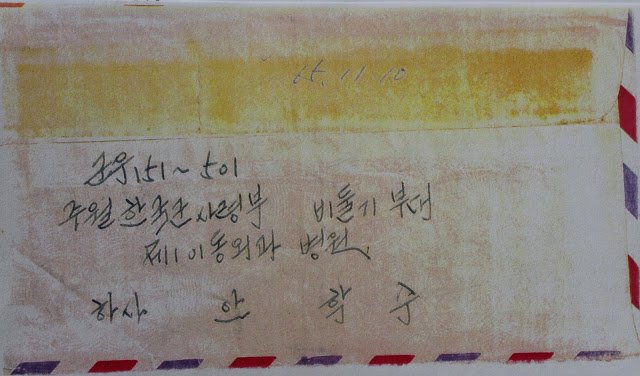
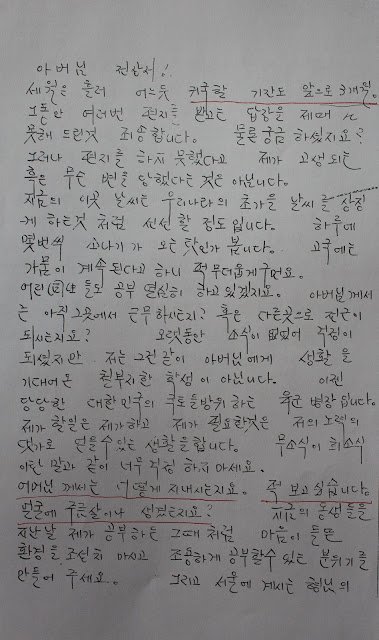
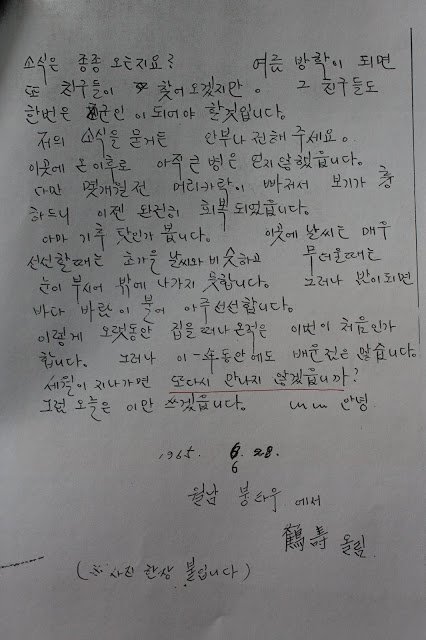
The letter that Staff sergeant, Ahn Hak-soo sent to his father in 1965. There was no reason for Ahn to all of a sudden defect.
Every semester, Yong-soo was dragged 2-3 times to the Army Security Command. One day in April of 1968, when it hadn’t yet even been a whole month since he began attending Pohang High School, he was called out by Section Chief Choi in the middle of class. Handing him a piece of paper, Choi demanded that Yong-soo write out his family’s whereabouts. It didn’t just stop at his immediate family; he had to write about his aunts, uncles, and distant relatives too.
The crux of the exercise was “Who came to visit the family.” Section Chief Choi, who was a sergeant, tortured Yong-soo in various ways and with such fervor, as if there were a reward involved. He put Yong-soo through water torture and hung him upside down with a rope and interrogated him in that state. He took him up a mountain where he made Yong-soo kneel and threatened him saying he could kill him right then and there and nobody would know. The most terrifying prank he would play was putting an empty gun to Yong-soo’s head and pulling the trigger. In such moments, Yong-soo’s mind would go blank in horror.
At night, the bamboos behinds their official residence would howl in the wind. The rustling noises would have them almost believe that somebody was approaching. The family’s sense of hearing became extremely acute. They were terrified. Hak-soo, who had defected to North Korea from Saigon, did not return. But neither did any North Korean secret agent. Each of the family members struggled to fall asleep at night. Yong-soo even suffered from depression and socialphobia. He couldn’t control his emotions. He had constant ringing in his ears, and his heart beat rapidly. When he lay down, it would feel like that ceiling would come tumbling down on him. He would even have illusions of a phantomlike figure choking him. The phantom could have been anyone; it could’ve been the Viet Cong that kidnapped his brother and took him to North Korea. It could have been Section Chief Choi.
One day in October of 1968. He decided suicide was his only means of revenge. Determined, he would go up to the rooftop of the school building, but dying was easier said than done. He attempted a total of four times, but failed to end his life each time.
- Written by humank (Journalist; Seoul, Korea)
- Translated and revised as necessary by April Kim (Tokyo, Japan)
The numbers in parentheses indicate the respective ages of the people at the time in 1968. This series will be uploaded on Steemit biweekly on Monday.